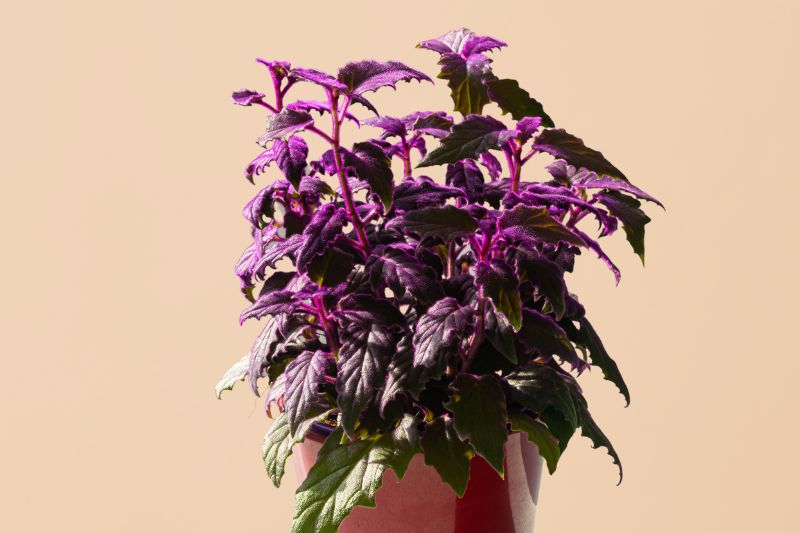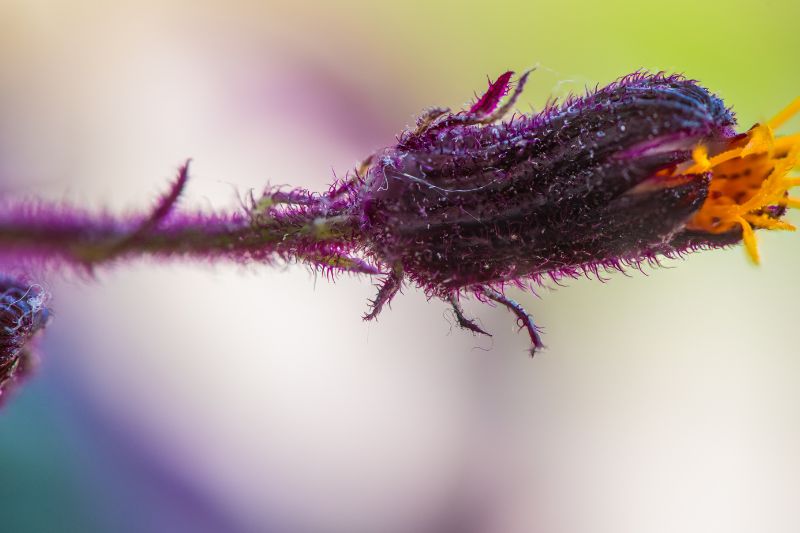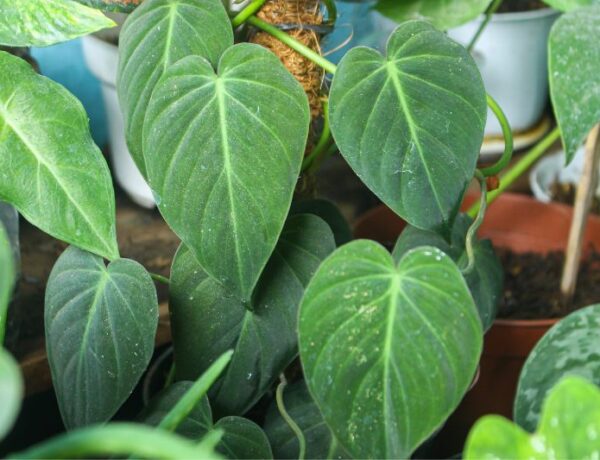Purple Passion Plant Care Snapshot
Your Purple Passion brings bold, velvety color to your space—and thrives on simple, soak-and-dry care. Here’s how to keep its plush foliage popping.
Watering
When top inch of soil is dry (about weekly)
Light
Bright, indirect light
Growth rate
Moderate to fast in ideal conditions
Care level
Beginner friendly
Pet-Friendly
Non-toxic to cats & dogs
Velvet Leaves & Orange Blooms
Purple Passion (Gynura aurantiaca) is all about texture—each serrated leaf is covered in fine, violet hairs that glow brighter along the edges and deepen to dark plum at the center, giving the plant its “velvet” reputation.
Young plants grow upright at first, then their fuzzy stems loosen and trail over pot rims or hanging baskets, showing off those glowing edges from every angle.
Surprise orange blossoms—musty and fleeting—signal peak maturity (and a quick fade). Snip them or root a couple of cuttings to keep your Purple Passion’s velvet foliage going.

Purple Passion Plant Care & Growing Requirements
Ready to keep that velvet fuzz happy? Here are the essentials:
Watering Schedule
Purple Passion likes a thorough soak, then a full dry-down—usually every 7–10 days in bright rooms. May stretch to 12–14 days in cooler, low-light spots.
Quick Tips:
- Water until you see runoff, then drain the saucer.
- Let the top 1 in / 2–3 cm of soil go dry before the next drink.
- Use room-temperature, filtered or distilled water.
- Cut watering in winter when growth slows.
- Never leave the pot standing in water.
Light & Placement
Bright, indirect light keeps the velvet purple; harsh sun scorches, low light turns stems leggy.
Quick Tips
- Aim for 4–6 hours of filtered light near an east- or west-facing window.
- Soften strong midday rays with a sheer curtain.
- Rotate the pot weekly for even color.
- Keep at least 2 ft / 60 cm from heaters, A/C, or cold drafts.
- Slide closer to the window in winter to offset weaker daylight.
Soil & Repotting
A light, peat-based mix with extra perlite keeps roots airy; repot only when tight—about every 1–2 years.
Quick Tips
- Blend equal parts peat moss, perlite, and quality potting soil.
- Always use a pot with drainage holes.
- Repot in spring, moving up just one size.
- Gently tease circling roots; trim any mushy spots.
- Top-dress with fresh mix instead of over-potting.
Humidity & Temperature
Average indoor air works, but 50 %+ humidity and 65–80 °F / 18–27 °C keep foliage plush.
Quick Tips
- Set the pot on a pebble tray without submerging roots.
- Group plants or run a small humidifier if air is dry.
- Keep nights above 55 °F / 13 °C to prevent leaf drop.
- Avoid vents, heaters, and drafty windows.
- Browning tips often signal low humidity or sudden chills.
Propagation
Stem cuttings root fast—share the velvet love or back up an aging plant.
Quick Tips
- Snip a 4–6 in / 10–15 cm stem just below a node; remove lower leaves.
- Let the cut end callous 1–2 days.
- Root in water or moist, well-draining mix; change water often.
- Roots appear in 2–4 weeks—pot up when 1 in / 2–3 cm long.
- Use a rooting hormone for a speed boost (optional).
Fertilizer
Feed lightly: half-strength balanced fertilizer once a month in spring and summer, skip in dormancy.
Quick Tips
- Use a balanced 10-10-10 (or similar) at ¼–½ strength once a month in spring and summer.
- Water first, then fertilize to avoid burn.
- Skip feeding in fall and winter.
- Flush the pot with plain water every three months to clear salts.
Flower Care
Tiny orange blooms are pretty but musty; if allowed to mature, they often trigger plant decline because Purple Passion is effectively monocarpic.
Quick Tips
- Pinch buds early to keep foliage lush.
- If blooms open, move the pot outdoors to enjoy the color, not the scent.
- Take stem cuttings before or during flowering to start fresh plants.
- Spent blooms? Snip them off to redirect energy to new growth.
- Expect some leaf drop after flowering—propagation is your backup.
Essentials & Stylish Accents
Equip your Purple Passion with lightweight soil, chic planters, and fuss-free feeding—everything you need for lush, velvety growth.

Miracle-Gro indoor potting mix
A lightweight coco-coir blend with slow-release nutrients. Add a scoop of perlite for the sharp drainage fuzzy roots love.
Shop on Amazon →
Ceramic planter duo (6″ & 5″) – blue
Rich blue stoneware pots with drainage holes—just the right size to spotlight that neon-violet foliage.
Shop on Amazon →
Glass mushroom propagation station
Five mini vases ready for rooting fresh Purple Passion cuttings—and doubling as a quirky display.
Shop on Amazon →
Miracle-Gro indoor plant food
A one-pump, 1-1-1 liquid feed; apply every few weeks at half strength during spring and summer for vibrant growth.
Shop on Amazon →As an Amazon Associate, I earn from qualifying purchases—thanks for supporting our plant guides!
Foliage & Close-Up Gallery



Purple Passion Got Questions? We’ve Got Answers
How do I keep the purple color vibrant?
Bright, indirect light is the secret sauce. Give Purple Passion 4–6 hours of filtered sun (east or west window).
If the leaves fade to green, scoot the pot closer to the light—just avoid harsh noon rays that can scorch the fuzz.
Why are the leaf tips turning brown?
Usually it’s dry air or inconsistent watering. Aim for moderate humidity (a pebble tray works) and let the top inch of soil dry, then water thoroughly.
Brown tips can also pop up if fertilizer salts build up—flush the soil with plain water every few months.
Does Purple Passion flower smell bad?
Yes. The bright orange bloom looks cool but smells musty—some say like mildew, others say “old attic.”
Many people remove the buds before they open.
Can I move my Purple Passion outdoors?
Yes, but ease it in. Set the pot in bright shade first, then gradually give it morning sun.
Bring it back inside before nights drop below 55 °F / 13 °C, and keep the fuzzy leaves dry during rain to avoid rot.
Is Purple Passion toxic to pets?
Good news: it’s non-toxic to cats and dogs, according to the ASPCA.
Still, not ideal as a snack—those fuzzy leaves can cause tummy trouble if chewed.
How do I propagate Purple Passion?
Snip a stem with at least one node, remove the lower leaves, and place it in water or moist soil. Keep it warm and well-lit, and roots should pop out in 1–3 weeks.
Is misting okay for those fuzzy leaves?
Skip the mist. Water droplets cling to the hairs and invite fungal spots.
Boost humidity with a pebble tray, grouping plants, or a room humidifier—anything that keeps moisture around the plant without wetting the foliage.
How big does Purple Passion get indoors?
With bright light and regular pruning, most plants top out around 18 in / 45 cm tall, then trail another foot or so.
Older stems can be trimmed to keep the plant compact.
Why are my Purple Passion leaves curling?
Curling usually points to underwatering or low humidity.
Check that the top inch of soil hasn’t stayed bone-dry for too long and boost humidity with a pebble tray if indoor air is very dry.
Conclusion
Give your Purple Passion bright, indirect light, a soak-then-dry drink schedule, and a bit of humidity, and it will reward you with velvety purple drama—right up until those quirky orange blooms signal its final act. Snip a cutting or two ahead of time, and the velvet show never really ends.
Craving more color? Check out our roundup of green-and-purple houseplants and build a whole jewel-toned squad—your Purple Passion could use a few equally flashy roommates!






No Comments